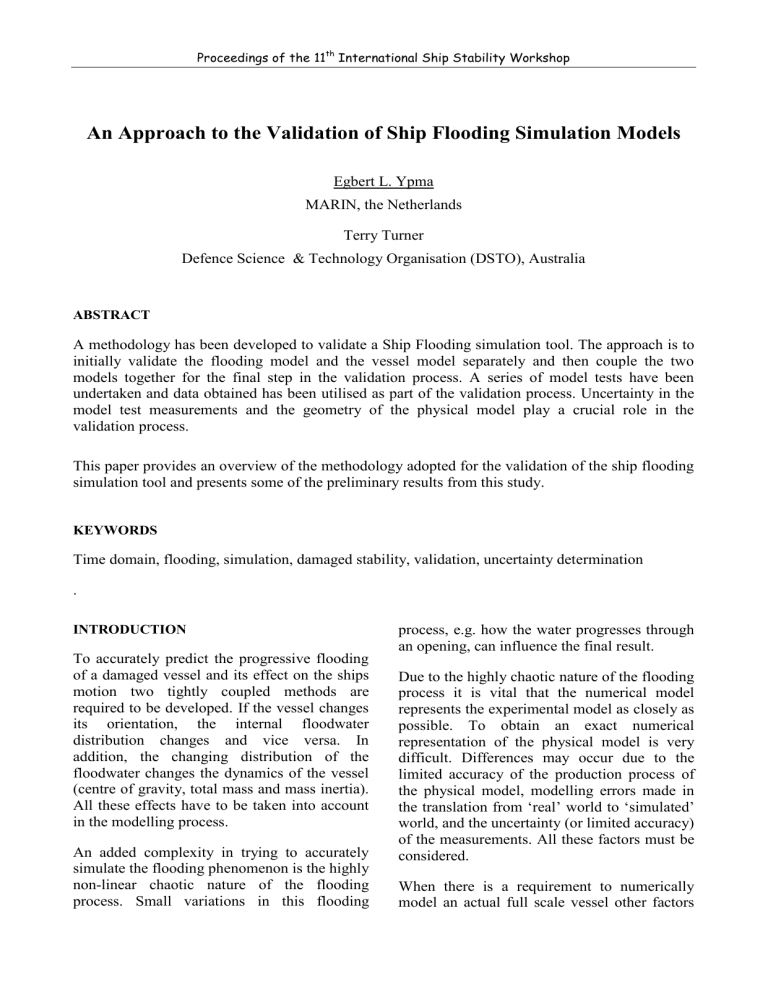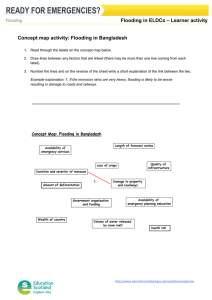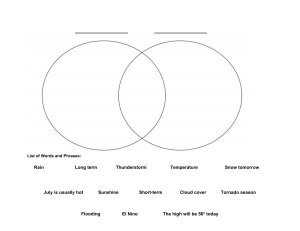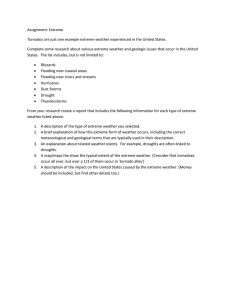An Approach to the Validation of Ship Flooding Simulation Models - Ypma & Tuner - 2016
advertisement

Proceedings of the 11th International Ship Stability Workshop An Approach to the Validation of Ship Flooding Simulation Models Egbert L. Ypma MARIN, the Netherlands Terry Turner Defence Science & Technology Organisation (DSTO), Australia ABSTRACT A methodology has been developed to validate a Ship Flooding simulation tool. The approach is to initially validate the flooding model and the vessel model separately and then couple the two models together for the final step in the validation process. A series of model tests have been undertaken and data obtained has been utilised as part of the validation process. Uncertainty in the model test measurements and the geometry of the physical model play a crucial role in the validation process. This paper provides an overview of the methodology adopted for the validation of the ship flooding simulation tool and presents some of the preliminary results from this study. KEYWORDS Time domain, flooding, simulation, damaged stability, validation, uncertainty determination . INTRODUCTION To accurately predict the progressive flooding of a damaged vessel and its effect on the ships motion two tightly coupled methods are required to be developed. If the vessel changes its orientation, the internal floodwater distribution changes and vice versa. In addition, the changing distribution of the floodwater changes the dynamics of the vessel (centre of gravity, total mass and mass inertia). All these effects have to be taken into account in the modelling process. An added complexity in trying to accurately simulate the flooding phenomenon is the highly non-linear chaotic nature of the flooding process. Small variations in this flooding process, e.g. how the water progresses through an opening, can influence the final result. Due to the highly chaotic nature of the flooding process it is vital that the numerical model represents the experimental model as closely as possible. To obtain an exact numerical representation of the physical model is very difficult. Differences may occur due to the limited accuracy of the production process of the physical model, modelling errors made in the translation from „real‟ world to „simulated‟ world, and the uncertainty (or limited accuracy) of the measurements. All these factors must be considered. When there is a requirement to numerically model an actual full scale vessel other factors Proceedings of the 11th International Ship Stability Workshop also must also be considered. The internal geometry of a full scale ship is extremely complicated and it would be very difficult to account for all the small details that may influence the flooding process. Issues such as leaking doors and collapsing air ducts are highly random events that can never be accounted for numerically. For this reason several “acceptable” assumptions are required to be made when numerically modelling full scale ships. Due to the highly chaotic nature of the flooding process and the various areas of uncertainties in both model scale and full scale vessels, a method for progressive flooding tools must be developed to account for these uncertainties at an acceptable level. The following three questions need to be carefully considered when defining this method: 1. How can a validation process be defined such that it is possible to conclude whether a simulation tool is sufficiently accurate? 2. Is it possible to define general rules to model the internal ship-geometry in such a way that the simulation tool predicts extreme events sufficiently accurate (both statistically and in magnitude)? 3. What is the best way to deal with uncertainties in the validation process? This paper will provide a brief overview of the numerical tool Fredyn [see Fredyn v10.1 2009] and its progressive flooding modelling capability and will also outline the approach undertaken by both The Maritime Institute Netherlands, (MARIN), and The Defence Science and Technology Organisation, (DSTO) for the validation of the progressive flooding module. SHIP MOTION AND PROGRESSIVE FLOODING SIMULATION MODEL Background The Cooperative Research Navies group, (CRNav), was established in 1989 to initiate a research program focussed on increasing the understanding of the dynamic stability of both intact and damaged naval vessels. The group has representatives from Australia, Canada, France, The Netherlands, the United Kingdom and the United States. The CRNav aims to increase the understanding of the stability of Naval vessels from a more physics based approach rather than an empirical derived one. To manage this process the CRNav has formed the Naval Stability Standards Working Group (NSSWG). The objective of the NSSWG is to investigate the applicability of the quasi-static, empirical based Sarchin and Goldberg stability criteria for modern Navy vessels and to develop a shared view on the future of naval stability assessment. Until recently, the main focus of the NSSWG has been on intact stability and so far this has been a fairly comprehensive and complex task. However with the recent development of the new flooding module within Fredyn, future programs of work will be focused on the damage stability of naval vessels. The flooding simulation model was developed and implemented by MARIN and funded by the CRNav group. In 2009 a collaboration agreement was signed between the CRNav and the Cooperative Research Ships, (CRS), working group ShipSurv II to jointly develop and validate the flooding module. In 2009 and 2010, the Defence Science and Technology Organisation, (DSTO), Australia, in collaboration with The Australian Maritime College, (AMC), have undertaken a research program to support MARIN in the validation of the progressive flooding module. In theory the flooding module can be interfaced to any 6D vessel (large) motion simulation Proceedings of the 11th International Ship Stability Workshop program. Currently, however, it is interfaced to Fredyn, jointly developed by MARIN with the CRNav, and PRETTI (jointly developed by MARIN and the CRS group). Fredyn was used for all the examples in this paper. The Simulation Model To enable an accurate simulation of the flooding of a damaged vessel operating in waves the simulation model describing the motions of the vessel and the model that determines the progressive flooding mechanism must be closely coupled to each other. Figure 1 shows an example of the typical information that is required to be interchanged between the simulation models.. Total Mass, CoG & Inertia Vessel Simulation Model Flooding Module Vessel Motions Figure 1 Interface Vessel model and flooding model In the scenario with significant flooding onboard a vessel, it is not unusual for sudden large changes in the vessels motions to occur. For an accurate simulation of this event both the flooding model and the vessel motion model must take this into account. The simulation must also be able to calculate a changing mass, centre of gravity and inertia over time. The accuracy of the roll damping model utilised is also vital in modelling this scenario. The relative wave height at the damage location is also required to be accurately predicted. FREDYN© FREDYN© is an integrated sea keeping and manoeuvring ship simulation tool capable of predicting large ship motions in extreme conditions. The development of FREDYN was jointly funded over the last 20 year period by MARIN and the CRNav. Over the years a substantial effort was made to validate and improve the code with model test experiments. FREDYN uses the frequency domain tool Shipmo2000 as a pre-processor to calculate the frequency dependent added mass and damping coefficients. Using a panellised hull form the program is capable of calculating the FroudeKrylov forces on the instantaneous wetted hull. An appropriate roll damping model can be selected which can be tuned to satisfaction when roll decay data is available. The standard vessel manoeuvring model is based on a frigate hull form but can be replaced with a dedicated, specifically tuned model when required. A wide variety of simulation components is available to model the vessel‟s propulsion and manoeuvring: rudders, fins, skegs, bilge keels, various propeller types, waterjets, trim-flaps, etc. The forces calculated by these sub-models are partly empirical based. A separate module is used to control the vessel‟s heading and/or attitude. The environment can be modelled by wind and by various wave systems coming from different directions. The wind and wave systems can be specified by making a selection from one of the available spectra. Together with the user specified parameters this will generate a (random) wave sequence (or varying wind speed). The equations of motions are based on Newton‟s second law: the forces and moments of all the sub-models are calculated, transferred to the space-fixed reference frame attached to the ship‟s centre of gravity, and summed. It eventually results in the momentum rate. Fredyn allows for time-varying mass properties to be able to deal with the potentially large mass fluctuations caused by the flooding process. To increase the flexibility a (python) scripting module allows to interact with the simulation program without altering its code. The scripting functionality can be used to program Proceedings of the 11th International Ship Stability Workshop vessel trajectories, implement speed pilots or do more advanced logging. Over the last year the software was completely restructured resulting in a very modular and highly configurable simulation program that can be very easily extended by additional modules. More recently, efforts are made to incorporate the steady forward wave and the diffracted and radiated wave patterns to improve the calculation of the wave profile close to the moving hull. Flooding Module The flooding module is used to calculate the flow of water and air through a user specified geometry. It assumes a horizontal fluid surface at all times. The effect of air-compressibility and its effect on the flow of water is fully taken into account. The compartment geometry is represent by tank-tables that are generated prior to the simulation. A tank-table for a compartment tabularises the relation between heel, trim of the vessel, level of the fluid in the compartment and the volume of the fluid, centre of gravity and inertia matrix. Interpolation on actual heel, trim and level values is used to find intermediate values. Any number of openings can be specified connecting two tanks or a tank to the sea. A single opening consists of four corner-points that specify the size and orientation of the opening. For each opening a constant discharge coefficient for water and a separate discharge coefficient for air has to be specified. If required, the user can specify a leaking pressure and area, a collapse pressure and a start- and/or stop time. An opening either connects two tanks or connects a single tank to the sea. It is also possible to define a duct between two tanks, or between a tank and the sea. Bernoulli‟s equation for incompressible media is used to determine the flow velocity of fluid along a stream line from the centre of a compartment (A) to the opening (B) pB 1 . 2 pA w .vB2 g. w . hB hA 0 (1) In this application of Bernoulli‟s equation the is constant and the velocity in point A, the centre of the compartment, is neglected. The variables p A and p B are the air pressures above the fluid in the compartment (A) and on the other side of the opening (B). After determining the velocity in the opening the mass flow through an entire opening is determined by integration over the height of the opening (along the local vertical): H mw w .Cd , w . width z .vB z .dz (2) 0 Where C d is the discharge coefficient specified by the user for this opening. It takes all the losses into account caused by contraction, pressure losses etc. A similar procedure is used to determine the mass flow of air through an opening and the Bernoulli‟s equation for compressible flow is used: p0 0 . ln pB ln p A 1 2 .vB 2 0 (3) The flooding process is considered isothermal, hence Boyle‟s law applies and thus the density of air is assumed to vary linearly with the pressure. The pressure correction method developed for air and water flows by Ruponen [see Ruponen 2007] is used to solve the coupled flow of fluid and air through a complex user defined geometry. The pressure correction method is using the equation of (mass)continuity and the linearised equations of Bernoulli to correct the water levels and air-pressures in an iterative method until the error in mass flow drops Proceedings of the 11th International Ship Stability Workshop below a user specified minimum. Upon conversion both the equations of mass continuity and momentum are satisfied. FREDYN FLOODING MODEL VALIDATION As previously discussed it is extremely difficult to model and capture all the phenomena that occur during the flooding of a vessel. For this reason there will always be slight variations in the experimental results when compared to the numerically predicted results. There are several factors that contribute to the differences observed. These include: The issue with the uncertainty covered by the physical model and measurements can be solved by firstly having a clear understanding of the uncertainties involved and secondly by undertaking a series of simulations to determine the influence that these uncertainties have on the overall result. The uncertainty in both the flooding and vessel motion models can be solved by separating the validation of the flooding model and the vessel simulation model. The validation process can then be split into several phases: 1. Fully constrained model. Measurement accuracy (motions, levels) Determination of the hydrostatic & dynamic properties of the model Production accuracy of the test model (both internal & external) Choices made during the modelling of the internal geometry (deck and bulkhead positions, permeability) Imperfections caused by mathematical modelling (empirics!) These uncertainties can be grouped in 3 main categories: Uncertainties caused by the physical model & the measurements Uncertainties caused by flooding model Uncertainties caused by the vessel model. The first category plays a role during the model testing, the second two are tightly coupled and play a role during the simulations. The result of the validation process will be a comparison between the measurements and the simulation data. In general, when they are „acceptably‟ close then the conclusion is justified that the simulation application performs well. The first key problem in view of the nature of the process and the uncertainties that play a role is how to define „acceptable‟. The second key problem is that if the result is not „acceptable‟ then which sub-model has to be changed to improve the result. Fully constraining the model in a predescribed heel, trim and draft allows for a check of the flooding module without the dynamics of the vessel. By using a heel and trim value different from zero the performance of the flooding module for inclined openings can be validated. In addition, the geometry of the numerical model can be verified. 2. Force the measured motions from the model test upon the flooding module. In this validation process the motions measured experimentally are prescribed onto the numerical model and the water levels and volumes in each compartment are determined. These levels and volumes are then compared to those obtained experimentally. If the flow rate into a compartment is different between the measured and the predicted, then the opening coefficient(s) of the compartment openings can be tuned. However, for complex geometries this might become a very difficult task. This process is a verification that the flooding model is working correctly. This approach is shown in Figure 1. Proceedings of the 11th International Ship Stability Workshop 1 Modeltest Measurements Measured Motions 2 Flooding Module Criteria Measured Levels Simulated Levels 4. Close the loop and combine both models 3 Comparison Performance Conclusion Figure 1 Flowchart showing the approach for the Prescribed Motion Phase 3. Use the result of step 2 (a time-varying, ‘wandering’ mass of all the flood-water) and use it to excite the dynamic vessel model. When the outcome of step 2 is summed it can be replaced by a single, time-varying mass (having a centre of gravity, inertia and a weight) that moves over and throughout the vessel. This approach is allowed as long as the vessel is only excited by this wandering and changing floodwater mass and will not be applicable when the vessel is also subject to other external forces such as waves. 1 Modeltest Measurements 2 Flooding Module Total Mass, CoG & Inertia Criteria Measured Motions during the model test. A schematic showing this process is shown in Figure 2. It is a test of the quasi-static flooding model approach and of the interface between the flooding module and the vessel simulation program. 3 Vessel Simulation Model Simulated Motions 4 Comparison Performance Conclusion Figure 2 Flowchart showing the approach for the Moving Mass Phase The outcome of this step (vessel motions) can be compared with the measured vessel motions The final step in the validation process is to undertake a simulation with the complete model i.e. vessel model and flooding model, and compare the predicted levels and motions with the measured modeltest data. A schematic outlining this process is shown in Figure 3. 1 Modeltest Measurements 2 Flooding Module Total Mass, CoG & Inertia Measured Motions & Measured Levels Criteria 3 Vessel Simulation Model Simulated Levels Simulated Motions 4 Comparison Performance Conclusion Figure 3 Flowchart showing the approach for the Full Simulation Phase Component & interface verification Prior to using the measurements in this approach, the validation method was verified by replacing the model test measurements with the data obtained from the fully coupled system. The process flow of this test is shown in Figure 1. Proceedings of the 11th International Ship Stability Workshop compartment arrangement at a later stage. The compartment block was located aft of amidships. 1 Flooding Module & Fredyn Simulated Motions I 2 testHarness & Flooding Module 4 Comparison Figure 5 A photograph of the generic destroyer model Total Mass, CoG, Inertia 3 Moving Mass & Fredyn Simulated Motions II Figure 4 Component Verification The motions as calculated by step 1 and 3 should compare very well as modeling errors play no role. It is a test of the interfaces and coordinate transforms involved. MODELTESTS The model tests undertaken at AMC were performed in two phases. Prior to undertaking these experiments, it was expected that the tests were going to be complex and the lessons learned from Phase 1 would be incorporated into the second phase of testing. The test program was set up in such a way that the complexity of the scenario was gradually increased. A priori simulations were performed to determine the most interesting loading conditions. Prior to the flooding tests roll decays at zero speed were undertaken, in both damaged and intact condition. The roll decay data was used to tune the roll damping of the simulation model. Fully constrained model tests were performed with a initial heel and trim of zero. In later tests a series of runs were performed with a range of non zero initial heel and trim combinations. The experimental model used, shown in Figure 5, was a generic destroyer design (scale 1:40, length approx. 3.0 meters) with a detailed internal geometry. The model was built in such a way that the damaged compartment block could be replaced with a more complex Two compartment arrangements were constructed and are referred to as simple and complex compartments. The difference between the simple and the complex model was the addition of (longitudinal and athwart) gangways. These arrangements comprised of 3 decks, 19 compartments of which 6 had level measurements and 2 had air pressure measurements. In addition to these measurements the 6 motions of the vessel were also recorded along with both internal and external video. The flooding was initiated by puncturing a latex membrane that covered the large damage opening as seen in Figure 6. Figure 6 The A photograph showing the generic destroyer damage opening During the model tests many precautions were taken to reduce the uncertainty of the results. After each run a calculation tool was used to check the equilibrium levels in each (measured) tank with respect to each other and to the still water plane. After each run a check of the (level) calibration was done. A run was repeated when spurious results were suspected. Proceedings of the 11th International Ship Stability Workshop After the tests the model was carefully remeasured to ascertain the „as build‟ situation. VALIDATION RESULTS The validation methodology approach, as previously described, has been applied to the data obtained with the first phase of the model test done at AMC. The results described in this paper are preliminary due to the final set of data (of phase II) not being available at the time of the analysis. The validation was performed in following steps: 1. 2. 3. 4. 5. 6. 7. were performed, each with a different initial angle. Only slight tuning of the radius of gyration, kxx , value was required to have a good resemblance of the measured and the simulated data for all initial roll angles. A typical comparison between the numerically predicted and the experimentally obtained roll decay is shown in Figure 8. Component & interface verification The vessel roll damping Vessel hydrostatics Fully Constrained Forced Motions Moving Mass Unconstrained Analysis All plots and other data are given in full scale. Component & interface verification The roll angle was selected as performance indicator for this step. Both data sets lie on top of each other, indicating a successful check. Figure 8 Roll decay for initial angle of 15 degrees Vessel hydrostatics & tanktables To check the hydrostatics of the simulation model, each tank was filled individually at 50%, 100% and at an intermediate value determined by an unconstrained simulation run. This was done both in FREDYN and PARAMARINE©, [see PARAMARINE© 2009] the latter program was used to generate the tanktables used in the flooding simulation. The equilibrium values for heel, pitch, draft and tank centre of gravity were compared. Slight differences were found. After completion of Phase 2, the actual dimensions of the experimental model were verified and slight differences were observed to those dimensions used in the preliminary analysis. Verification of the hydrostatics will be repeated using the re-measured dimensions. Figure 7 Component verification - Roll angle comparison Fully Constrained Vessel roll damping model During the model test the model was fully constrained at zero heel and trim. This test gives an indication of the performance of the flooding module. The influence of the motions of the vessel on the flooding process is not The roll decay data was used to tune the roll damping model. All flooding tests were done at zero speed hence only the roll damping for that speed required to be tuned. Several roll decays Proceedings of the 11th International Ship Stability Workshop considered at this stage due to the model being fully constrained in all six degree of freedom.. Figure 9 shows an example of both the simulation and experimental time traces of the water level in a compartment that floods through a number of openings and other compartments. The air pressure in this compartment remains ambient as the compartment is open to the outside. The discharge coefficient for all the openings are set to a default value of 0.58. Forced Motion For the forced motion analysis the experimental model motions (heave, pitch roll) were used to drive the flooding module. To be able to do this a small test Harness application was created which loads a file with motion data and the flooding component. Figure 10 shows a comparison between the simulation and model tests results along with the expected uncertainty. The simulation of the flooding of this compartment shows excellent comparison to the experimental data. The arrival of the water at the position of the probe, the filling rate of the compartment and the final equilibrium level are all predicted extremely well. A full uncertainty analysis was undertaken. which incorporated the uncertainties for level and calibration measurement and uncertainties in the as-build situation. The 95% values (2*σ) used in the calculation of uncertainties are 2.0 mm for the level sensor accuracy and 4.0 mm for the geometry uncertainty (model scale values). Preliminary results from the model tests suggest that the 2.0 mm might be too low. The 95% range appeared to be around +/-0.20 m (full scale) and is indicated by the unconnected dots shown in Figure 9. Figure 9 Comparisons between predicted and experimental compartment water levels. Figure 10 Comparisons between predicted and experimental compartment water levels. There is a difference between the model test and the simulation slightly outside the limits of uncertainty. The difference is approximately constant as soon as the equilibrium is reached. The compartment which Figure 10 is referring to is connected to the sea and is fully ventilated, therefore at equilibrium, the distance between the water level in the compartment and the still water plane should be zero. Proceedings of the 11th International Ship Stability Workshop Figure 12 Comparisons between predicted and experimental compartment water levels Figure 11 Distance to still-water plane (simulation) Figure 11 shows the distance between the water level within the compartment and the still water plane over time. It is evident that the simulation is predicting the water level within the compartment accurately. When the experimental data is used (level, heel, pitch, heave and draft) and the equilibrium value for the distance to the still water plane is calculated, then the difference is 0.23 [m], full scale. It should be noted that after undertaking this preliminary analysis the physical experimental model was re-measured and slight differences in the geometry details used in this analysis were found. It is planned to undertake this analysis again with the new geometry details. This compartment is located adjacent to the damage opening. When the equilibrium measurement for this compartment is used, then the calculated difference between the compartment water level and the still water plane is 0.03 [m], which is well within the estimated uncertainty limits. Moving Mass Using the results from the forced motion runs a time record of the total flooding mass and its center of mass can be determined. These values are then used to excite the vessel model. The roll, pitch and heave motions of the simulation vessel can then be compared against the modeltest values. Figure 13 shows the comparison between the experimental and simulated results. Figure 12 shows the water level within a different compartment over time for both the simulation and model tests. Figure 13 A comparison between the roll versus time for both the simulated and experimental analysis. Proceedings of the 11th International Ship Stability Workshop The initial numerically predicted roll angle is larger than the measured value. This result is consistent with that shown in Figure 8. This compartment is on the port side of the vessel. The simulation predicts a smaller volume, (mass), of water in this compartment hence resulting in an increase roll to starboard, (roll angle is positive to starboard). Initially, also some fluctuations are visible. This is an indication that the experimental model has more internal damping. It will also be caused by the quasi-static approach in the flooding module for this highly dynamic model test. Figure 14 shows an good agreement between the numerically predicted magnitude of pitch compared to that obtained experimentally. Figure 15 A comparison between the roll versus time for both the simulated and experimental analysis It is evident that there is a significant difference between the numerically predicted and the experimental results. As stated previously, the comparisons shown in this paper are using the assumed geometry arrangement but the remeasuring of the model upon completion of the experimental phase has shown some slight variations in the assumed geometry. These slight variations at model scale may have significant effect on the results when modelling full scale. It is planned to undertake the complete validation process again using the updated geometry. Figure 14 Comparison of pitch motion Unconstrained run The final stage in the validation methodology is the complete coupling of the numerical flooding model with the numerical vessel model. Figure 15 and Figure 16 show a comparison between the numerically predicted roll and pitch motions compared with the experimentally obtained values. Figure 16 A comparison between the pitch versus time for both the simulated and experimental analysis Proceedings of the 11th International Ship Stability Workshop CONCLUSIONS This paper has provided an overview of the methodology that has been adopted by MARIN and DSTO to validate the progressive flooding modelling capability within Fredyn. This methodology included a phased approach where initially both the flooding model and the vessel model were validated separately and then coupled together for the last validation stage. A series of model tests were undertaken in support of this validation process. Preliminary findings have shown reasonably good results but have also highlighted the need to clearly identify the source and extents of uncertainties in the experimental program. This information can then be utilised to determine what is an “acceptable” level of agreement between the numerical predictions and the experimental results. The results presented in this paper are based on an assumed geometry of the experimental model and post trial geometry verification have shown slight differences in the geometry details. Ongoing validation studies are planned using the new geometry definitions. REFERENCES Fredyn v10.1, Theory & user Manual, MARIN, the Netherlands, 2009 PARAMARINE© v6.1, User Manual, GRC Ltd, United Kingdom, 2009 Ruponen, Pekka, Progressive Flooding of a Damaged Passenger Ship, Doctoral Dissertation, Helsinki University of Technology, 2007








